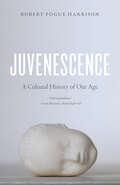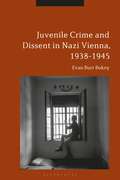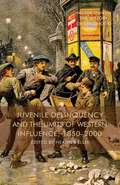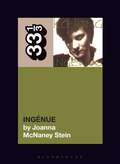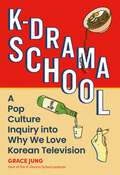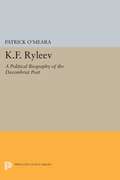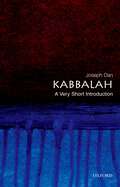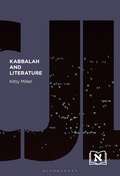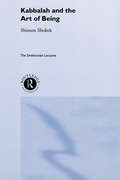- Table View
- List View
Juvenescence: A Cultural History of Our Age
by Robert Pogue HarrisonHow old are you? The more thought you bring to bear on the question, the harder it is to answer. For we age simultaneously in different ways: biologically, psychologically, socially. And we age within the larger framework of a culture, in the midst of a history that predates us and will outlast us. Looked at through that lens, many aspects of late modernity would suggest that we are older than ever, but Robert Pogue Harrison argues that we are also getting startlingly younger—in looks, mentality, and behavior. We live, he says, in an age of juvenescence. Like all of Robert Pogue Harrison's books, Juvenescence ranges brilliantly across cultures and history, tracing the ways that the spirits of youth and age have inflected each other from antiquity to the present. Drawing on the scientific concept of neotony, or the retention of juvenile characteristics through adulthood, and extending it into the cultural realm, Harrison argues that youth is essential for culture’s innovative drive and flashes of genius. At the same time, however, youth—which Harrison sees as more protracted than ever—is a luxury that requires the stability and wisdom of our elders and the institutions. “While genius liberates the novelties of the future,” Harrison writes, “wisdom inherits the legacies of the past, renewing them in the process of handing them down.” A heady, deeply learned excursion, rich with ideas and insights, Juvenescence could only have been written by Robert Pogue Harrison. No reader who has wondered at our culture's obsession with youth should miss it.
Juvenescence: A Cultural History of Our Age
by Robert Pogue HarrisonHow old are you? The more thought you bring to bear on the question, the harder it is to answer. For we age simultaneously in different ways: biologically, psychologically, socially. And we age within the larger framework of a culture, in the midst of a history that predates us and will outlast us. Looked at through that lens, many aspects of late modernity would suggest that we are older than ever, but Robert Pogue Harrison argues that we are also getting startlingly younger—in looks, mentality, and behavior. We live, he says, in an age of juvenescence. Like all of Robert Pogue Harrison's books, Juvenescence ranges brilliantly across cultures and history, tracing the ways that the spirits of youth and age have inflected each other from antiquity to the present. Drawing on the scientific concept of neotony, or the retention of juvenile characteristics through adulthood, and extending it into the cultural realm, Harrison argues that youth is essential for culture’s innovative drive and flashes of genius. At the same time, however, youth—which Harrison sees as more protracted than ever—is a luxury that requires the stability and wisdom of our elders and the institutions. “While genius liberates the novelties of the future,” Harrison writes, “wisdom inherits the legacies of the past, renewing them in the process of handing them down.” A heady, deeply learned excursion, rich with ideas and insights, Juvenescence could only have been written by Robert Pogue Harrison. No reader who has wondered at our culture's obsession with youth should miss it.
Juvenile Crime and Dissent in Nazi Vienna, 1938-1945
by Evan Burr BukeyDrawing on a wealth of archival sources, Evan Burr Bukey's meticulous new study offers the definitive account of juvenile crime in Nazi-era Vienna. In analyzing the records of juvenile delinquency in Vienna during the Anschluss era, this book explores the impact the Juvenile Criminal Code had on the Viennese youth who were brought before the bench for deviant behavior.Juvenile Crime and Dissent in Nazi Vienna addresses one key question: to what extent did Nazi rule constitute a rupture in the Austrian juvenile justice system? Ultimately this book reveals how, despite National Socialist institutions pervading Austrian society between 1938 and 1945, the survival of the indigenous legal order preserved a sense of regional identity that helps to explain the success of the Second Austrian Republic following the collapse of the Third Reich.
Juvenile Crime and Dissent in Nazi Vienna, 1938-1945
by Evan Burr BukeyDrawing on a wealth of archival sources, Evan Burr Bukey's meticulous new study offers the definitive account of juvenile crime in Nazi-era Vienna. In analyzing the records of juvenile delinquency in Vienna during the Anschluss era, this book explores the impact the Juvenile Criminal Code had on the Viennese youth who were brought before the bench for deviant behavior.Juvenile Crime and Dissent in Nazi Vienna addresses one key question: to what extent did Nazi rule constitute a rupture in the Austrian juvenile justice system? Ultimately this book reveals how, despite National Socialist institutions pervading Austrian society between 1938 and 1945, the survival of the indigenous legal order preserved a sense of regional identity that helps to explain the success of the Second Austrian Republic following the collapse of the Third Reich.
Juvenile Delinquency and the Limits of Western Influence, 1850-2000 (Palgrave Studies in the History of Childhood)
by Heather EllisThis volume brings together a wide range of case studies from across the globe, written by some of the leading scholars in the field, to explore the complex ways in which historical understandings of childhood and juvenile delinquency have been constructed in a global context.
Juvenile Justice (Historical Guides to Controversial Issues in America)
by Laura L. FinleyThroughout U.S. history, attitudes toward young people have vacillated between fear of and fear for. These attitudes impact social programs for youth, including the system of juvenile justice. Attitudes are shaped by the socio-political and cultural cliimate of the times, and can be traced back to colonial times. However, changing mores and values often create confusion and conflict, resulting in ineffective strategies for preventing and responding to juvenile delinquency. Tracing the history of juvenile justice back to the pre-colonial era through the present day, Finley sheds light on just how we arrived where we are in terms of juvenile justice. She connects the competing attitudes about young people to the social, economic, and political changes of a given era, and offers recommendations for establishing more effective and more humane policies toward juveniles in the justice system.Early America is known for its harsh treatment of young people, most notably, the stubborn child laws, which authorized use of the death penalty for children who defied their parents. Yet, even then, many people held more nurturing attitudes toward youth. Thus originated the mixed messages in the U.S. regarding juvenile delinquency and the hodgepodge of approaches that follow. The establishment of the juvenile justice system, founded on the concept of parens patriae, or the state as parent, would seem to have settled the debate over how juvenile offenders should be treated. In reality, however, there remains much controversy over how best to handle juvenile offenders, especially those who commit the most serious offenses. While some still maintain juveniles are developmentally different and should be treated in ways consistent with these differences, others are dismayed at what they feel to be a system that is too lenient and that leads to higher juvenile crime rates and more serious offenses.With the advent of three strikes laws, curfew laws, boot camps, and referring juveniles to adult courts, and subsequently assigning them to adult prisons, many question just how we got to this place in juvenile justice. Here, Finley offers the history behind the controversial goals and development of the juvenile justice system, providing detailed descriptions of the major trends in juvenile justice. Addressing the most current aspects of the controversy, she also sheds light on issues of race, social class, and gender. Offering recommendations for addressing the weaknesses and confusion in the system, Finley offers a unique and compelling perspective on controversial subject.
Juvenile Nation: Youth, Emotions and the Making of the Modern British Citizen, 1880-1914
by Stephanie OlsenIn the first five months of the Great War, one million men volunteered to fight. Yet by the end of 1915, the British government realized that conscription would be required. Why did so many enlist, and conversely, why so few? Focusing on analyses of widely felt emotions related to moral and domestic duty, Juvenile Nation broaches these questions in new ways.Through juvenile literature and an increasingly influential science of adolescence, Juvenile Nation explores the themes of loyalty, character, temperance, manliness, fatherhood, and religion. In the context of a widespread consensus on the ways to make men out of boys, an informal curriculum of emotional control, key to shaping the future citizenry of Britain and the Empire, is revealed.Juvenile Nation argues that the militaristic fervour of 1914 was an emotional outpouring based on association to family, to community and to Christian cultural continuity. Significantly, the same emotional response explains why so many men did not volunteer, with duty to family and community perhaps thought to have been best carried out at home. This is an important book that tells us much about the emergence of adolescence in modern Britain and the Empire.
Juvenile Nation: Youth, Emotions and the Making of the Modern British Citizen, 1880-1914
by Stephanie OlsenIn the first five months of the Great War, one million men volunteered to fight. Yet by the end of 1915, the British government realized that conscription would be required. Why did so many enlist, and conversely, why so few? Focusing on analyses of widely felt emotions related to moral and domestic duty, Juvenile Nation broaches these questions in new ways.Through juvenile literature and an increasingly influential science of adolescence, Juvenile Nation explores the themes of loyalty, character, temperance, manliness, fatherhood, and religion. In the context of a widespread consensus on the ways to make men out of boys, an informal curriculum of emotional control, key to shaping the future citizenry of Britain and the Empire, is revealed.Juvenile Nation argues that the militaristic fervour of 1914 was an emotional outpouring based on association to family, to community and to Christian cultural continuity. Significantly, the same emotional response explains why so many men did not volunteer, with duty to family and community perhaps thought to have been best carried out at home. This is an important book that tells us much about the emergence of adolescence in modern Britain and the Empire.
The Juvenile Tradition: Young Writers and Prolepsis, 1750-1835
by Laurie LangbauerA juvenile tradition of young writers flourished in Britain between 1750-1835. Canonical Romantic poets as well as now-unknown youthful writers published as teenagers. These teenage writers reflected on their literary juvenilia by using the trope of prolepsis to assert their writing as a literary tradition. Precocious writing, child prodigies, and early genius had been topics of interest since the eighteenth century. Child authors—girl poets and boy poets, schoolboy writers and undergraduate writers, juvenile authors of all kinds—found new publication opportunities because of major shifts in the periodical press, publishing, and education. School magazines and popular juvenile magazines that awarded prizes to child writers all made youthful authorship more visible. Some historians estimate that minors (children and teens) comprised over half the population at the beginning of the nineteenth century. Modern interest in Romanticism, and the self-taught and women writers' traditions, has occluded the tradition of juvenile writers. This first full-length study to recover the late-eighteenth and early-nineteenth-century juvenile tradition draws on the history of childhood and child studies, along with reception study and audience history. It considers the literary juvenilia of Thomas Chatterton, Henry Kirke White, Robert Southey, Leigh Hunt, Jane Austen, and Felicia Hemans (then Felicia Dorothea Browne)-along with the childhood writing of Byron, Mary Shelley, Percy Shelley, and John Keats-and a score of other young poets- "infant bards "-no longer familiar today. Recovering juvenility recasts literary history. Adolescent writers, acting proleptically, ignored the assumptions of childhood development and the disparagement of supposedly immature writing.
K: The Art Of Love
by Hong YingChina, 1930s. Julian Bell, son of the Bloomsbury set's Vanessa, is newly arrived in Peking. In search of fresh experiences, he encounters the beautiful, intelligent and deeply erotic Lin Cheng. Though Lin is wife to a university professor, their passionate assignations blossom into an affair. Schooled in the ancient Taoist arts of love, Lin instructs Julian in the ways of the East. But if society won't tolerate this union between Occidental and Oriental can their love possibly survive?Based on a true story this is a tragic tale of romance, betrayal and sexual desire set against a backdrop of conflict and war.
k.d. lang's Ingénue (33 1/3)
by Joanna McNaney SteinCanadian performer k.d. lang broke new ground in the 1980s by blending the genres of punk and country, dubbed “cowpunk,” with her band, the Reclines. Despite Grammy-award-winning recordings and frequent North American TV spots, mainstream country radio excluded lang from airplay due to her unconventional gender presentation and perceived sexuality. Not until lang's 1992 pop album Ingénue, the release of the single “Constant Craving,” and her subsequent coming out in The Advocate did lang earn critical acclaim worldwide. The book addresses lang's rise to fame after switching genres, the successful reinvention of her sound and persona, and how she found herself immersed in the whirlwind of MTV and the "lesbian chic" aesthetic of 1990s pop culture. As an LGBTQ author, Joanna McNaney Stein discusses her adolescence and sexual development by weaving in short narrative prose pieces with her analysis of lang and Ingénue. Also included are interviews with lang's musical collaborators: Ingénue co-writer Ben Mink, drummer Fred Eltringham, pianist Daniel Clarke, and singer-songwriter Laura Veirs.
k.d. lang's Ingénue (33 1/3)
by Joanna McNaney SteinCanadian performer k.d. lang broke new ground in the 1980s by blending the genres of punk and country, dubbed “cowpunk,” with her band, the Reclines. Despite Grammy-award-winning recordings and frequent North American TV spots, mainstream country radio excluded lang from airplay due to her unconventional gender presentation and perceived sexuality. Not until lang's 1992 pop album Ingénue, the release of the single “Constant Craving,” and her subsequent coming out in The Advocate did lang earn critical acclaim worldwide. The book addresses lang's rise to fame after switching genres, the successful reinvention of her sound and persona, and how she found herself immersed in the whirlwind of MTV and the "lesbian chic" aesthetic of 1990s pop culture. As an LGBTQ author, Joanna McNaney Stein discusses her adolescence and sexual development by weaving in short narrative prose pieces with her analysis of lang and Ingénue. Also included are interviews with lang's musical collaborators: Ingénue co-writer Ben Mink, drummer Fred Eltringham, pianist Daniel Clarke, and singer-songwriter Laura Veirs.
K-Drama School: A Pop Culture Inquiry into Why We Love Korean Television
by Grace JungFrom the Emmy Award-winning Squid Game to streaming sensations like The Glory and Crash Landing on You, Korean television has emerged onto the global pop culture scene as compelling television—but what exactly makes these shows so irresistibly bingeable? And what can we learn about our societies and ourselves from watching them? From stand-up comedian and media studies PhD Grace Jung comes a rollicking deep dive into the cultural significance of Korean television. K-Drama School analyzes everything from common tropes like amnesia and slapping to conspicuous product placements of Subway sandwiches and coffee; to representations of disability, race and gender; to what Korea's war-torn history says about South Korea&’s media output and the stories being told on screen. With chapters organized by "lessons," each one inquiring into a different theme of Korean television, K-Drama School offers a groundbreaking exploration into this singular form of entertainment, from an author who writes with humor and heart about shows that spur tears and laughter, keeping us glued to the TV while making fans of us all. Shows discussed include: Squid Game, SKY Castle, Crash Course in Romance, Extraordinary Attorney Woo, My Mister, Something in the Rain, One Spring Night, DP, Guardian: The Lonely and Great God, Autumn in My Heart, Winter Sonata, Our Blues, and more.
K.F. Ryleev: A Political Biography of the Decembrist Poet
by Patrick O'MearaThis book focuses particular attention on the six-month interrogation of the doomed poet, and it provides a critical evaluation of Soviet interpretations and an assessment of Ryleev's historical significance.Originally published in 1984.The Princeton Legacy Library uses the latest print-on-demand technology to again make available previously out-of-print books from the distinguished backlist of Princeton University Press. These editions preserve the original texts of these important books while presenting them in durable paperback and hardcover editions. The goal of the Princeton Legacy Library is to vastly increase access to the rich scholarly heritage found in the thousands of books published by Princeton University Press since its founding in 1905.
K. O. Mbadiwe: A Nigerian Political Biography, 1915–1990
by Hollis R. LynchThis book offers a comprehensive political biography of Kingsley Ozuomba Mbadiwe, (1915-1990), a central figure in Nigerian political history for more than forty years. Starting in 1936 as a protégé of Nnamdi Azikiwe, then Nigeria's most renowned nationalist, Mbadiwe himself by the 1950s became a frontline nationalist. And next to Tafawa Balewa from the North who became Prime Minster in 1957, he was the most important figure in the Nigerian Federal Government between 1952 and Nigeria's first military coup in 1966. During this time he held a succession of important Cabinet positions and was Parliamentary Leader of the National Council of Nigeria and the Cameroons (NCNC), which was in a ruling alliance with the Northern People's Congress (NPC). In contrast, his older prominent political contemporaries, Azikiwe of the Eastern Region, Igbo Leader of the NCNC; Obafemi Awolowo of the Western Region, Yoruba Leader of the Action Group (AG); and Ahmadu Bello of the Northern Region, Fulani Leader of the NPC, all carved out their political careers totally or largely at the regional level. Throughout his political career Mbadiwe's focus was always at the national level. Truly, it has been stated that Mbadiwe was one of the founding fathers of the Nigerian State. Nonetheless, Mbadiwe's ambition for himself to lead Nigeria and for his nation to set it on the path to greatness faced insuperable difficulties. In a country of widespread poverty, high illiteracy, and a grossly underdeveloped private sector, there were fierce ethnic and regional conflicts for the control of governments and resources, leading to massive corruption and serious instability. This in turn led to prolonged military rule twenty years in Mbadiwe's lifetime which was often more corrupt and repressive than civilian rule, and was bitterly deprecated by Mbadiwe.
Ka: Stories Of The Mind And Gods Of India (Penguin Modern Classics #Vol. 33901)
by Roberto Calasso'To read Ka is to experience a giddy invasion of stories - brilliant, enigmatic, troubling, outrageous, erotic, beautiful' The New York Times'Who?' - or 'ka' - is the question that runs through Roberto Calasso's retelling of the stories of the minds and gods of India; the primordial question that continues to haunt human existence. From the Rigveda to the Upanishads, the Mahabharata to the life of Buddha, this book delves into the corpus of classical Sanskrit literature to re-imagine the ancient Indian myths and how they resonate through space and time.'The very best book about Hindu mythology that anyone has ever written' Wendy Doniger'Dazzling, complex, utterly original ... Ka is his masterpiece' Sunday Times
Kabbalah: International Symposium Held In Frankfurt A. M. 1991 (Very Short Introductions #13)
by Joseph DanIn Kabbalah: A Very Short Introduction, Joseph Dan, one of the world's leading authorities on Jewish mysticism, offers a concise and highly accurate look at the history and character of the various systems developed by the adherents of the Kabbalah. Dan sheds light on the many misconceptions about what Kabbalah is and isn't--including its connections to magic, astronomy, alchemy, and numerology--and he illuminates the relationship between Kaballah and Christianity on the one hand and New Age religion on the other. The book provides fascinating historical background, ranging from the mystical groups that flourished in ancient Judaism in the East, and the medieval schools of Kabbalah in Northern Spain and Southern France, to the widening growth of Kabbalah through the school of Isaac Luria of Safed in the sixteenth century, to the most potent and influential modern Jewish religious movement, Hasidism, and its use of kabbalistic language in its preaching. The book examines the key ancient texts of this tradition, including the Sefer Yezira or "Book of Creation," The Book of Bahir, and the Zohar. Dan explains Midrash, the classical Jewish exegesis of scriptures, which assumes an infinity of meanings for every biblical verse, and he concludes with a brief survey of scholarship in the field and a list of books for further reading. Embraced by celebrities and integrated in many contemporary spiritual phenomena, Kabbalah has reaped a wealth of attention in the press. But many critics argue that the form of Kabbalah practiced in Hollywood is more New Age pabulum than authentic tradition. Can there be a positive role for the Kabbalah in the contemporary quest for spirituality? In Kabbalah, Joseph Dan debunks the myths surrounding modern Kabbalistic practice, offering an engaging and dependable account of this traditional Jewish religious phenomenon and its impact outside of Judaism. About the Series: Combining authority with wit, accessibility, and style, Very Short Introductions offer an introduction to some of life's most interesting topics. Written by experts for the newcomer, they demonstrate the finest contemporary thinking about the central problems and issues in hundreds of key topics, from philosophy to Freud, quantum theory to Islam.
Kabbalah: Secrecy, Scandal and the Soul
by Harry FreedmanThis book tells the story of the mystical Jewish system known as Kabbalah, from its earliest origins until the present day. We trace Kabbalah's development, from the second century visionaries who visited the divine realms and brought back tales of their glories and splendours, through the unexpected arrival of a book in Spain that appeared to have lain unconcealed for over a thousand years, and on to the mystical city of Safed where souls could be read and the history of heaven was an open book.Kabbalah's Christian counterpart, Cabala, emerged during the Renaissance, becoming allied to magic, alchemy and the occult sciences. A Kabbalistic heresy tore apart seventeenth century Jewish communities, while closer to our time Aleister Crowley hijacked it to proclaim 'Do What Thou Wilt'. Kabbalah became fashionable in the late 1960s in the wake of the hippy counter-culture and with the approach of the new age, and enjoyed its share of fame, scandal and disrepute as the twenty first century approached. This concise, readable and thoughtful history of Kabbalah tells its story as it has never been told before. It demands no knowledge of Kabbalah, just an interest in asking the questions 'why?' and 'how?'
Kabbalah: Secrecy, Scandal and the Soul
by Harry FreedmanThis book tells the story of the mystical Jewish system known as Kabbalah, from its earliest origins until the present day. We trace Kabbalah's development, from the second century visionaries who visited the divine realms and brought back tales of their glories and splendours, through the unexpected arrival of a book in Spain that appeared to have lain unconcealed for over a thousand years, and on to the mystical city of Safed where souls could be read and the history of heaven was an open book.Kabbalah's Christian counterpart, Cabala, emerged during the Renaissance, becoming allied to magic, alchemy and the occult sciences. A Kabbalistic heresy tore apart seventeenth century Jewish communities, while closer to our time Aleister Crowley hijacked it to proclaim 'Do What Thou Wilt'. Kabbalah became fashionable in the late 1960s in the wake of the hippy counter-culture and with the approach of the new age, and enjoyed its share of fame, scandal and disrepute as the twenty first century approached. This concise, readable and thoughtful history of Kabbalah tells its story as it has never been told before. It demands no knowledge of Kabbalah, just an interest in asking the questions 'why?' and 'how?'
Kabbalah and Literature (Comparative Jewish Literatures)
by Professor Kitty MilletFocuses on a range of Jewish and non-Jewish writers to examine the intersection of Kabbalah, the Jewish mystical tradition, and secular Jewish literatures.Kabbalah and Literature shows how the Jewish mystical tradition contributes to the renewal of literature in a modern, global, and increasingly disconnected age. Kitty Millet explores Kabbalah's conceptual underpinnings, aesthetic principles, tenets, and signifiers to demonstrate how literature's absorption of kabbalistic material has altered its ontology, function, and the tasks it sets for itself. Reading writers from Europe and the Americas, Kitty Millet maps how the kabbalist's desire to "recover Eden" transforms into a latent messianic drive only intuitable through text. Thus it charts a journey of sorts, a migration of Jewish mystical material embedded surreptitiously within text in order to shift ever so slightly at times the range of the literary to encompass an aesthetic vision not easily reducible to the literal, the known, the allegorical, or even the philosophical.In this way, Kabbalah and Literature proposes a novel, intuitive approach, shifting focus away from the Jewish text's epistemological elements to embrace its "secrets."
Kabbalah and Literature (Comparative Jewish Literatures)
by Professor Kitty MilletFocuses on a range of Jewish and non-Jewish writers to examine the intersection of Kabbalah, the Jewish mystical tradition, and secular Jewish literatures.Kabbalah and Literature shows how the Jewish mystical tradition contributes to the renewal of literature in a modern, global, and increasingly disconnected age. Kitty Millet explores Kabbalah's conceptual underpinnings, aesthetic principles, tenets, and signifiers to demonstrate how literature's absorption of kabbalistic material has altered its ontology, function, and the tasks it sets for itself. Reading writers from Europe and the Americas, Kitty Millet maps how the kabbalist's desire to "recover Eden" transforms into a latent messianic drive only intuitable through text. Thus it charts a journey of sorts, a migration of Jewish mystical material embedded surreptitiously within text in order to shift ever so slightly at times the range of the literary to encompass an aesthetic vision not easily reducible to the literal, the known, the allegorical, or even the philosophical.In this way, Kabbalah and Literature proposes a novel, intuitive approach, shifting focus away from the Jewish text's epistemological elements to embrace its "secrets."
Kabbalah and the Art of Being: The Smithsonian Lectures
by Shimon ShokekThis new approach introduces Kabbalah as a spiritual Jewish way of living, a practical wisdom for living, creativity and well being, and not merely a religious phenomenon or esoteric theology. Professor Shokek suggests that the Kabbalistic theme of Creation is the central ingredient in the spiritual teachings of Jewish mysticism. He skilfully reveals the core questions that emerge from the wisdom of the Jewish sages, opening up a lively avenue of debate in this increasingly popular area of study.
Kabbalah and the Art of Being: The Smithsonian Lectures
by Shimon ShokekThis new approach introduces Kabbalah as a spiritual Jewish way of living, a practical wisdom for living, creativity and well being, and not merely a religious phenomenon or esoteric theology. Professor Shokek suggests that the Kabbalistic theme of Creation is the central ingredient in the spiritual teachings of Jewish mysticism. He skilfully reveals the core questions that emerge from the wisdom of the Jewish sages, opening up a lively avenue of debate in this increasingly popular area of study.
Kabbalah: A Very Short Introduction (Very Short Introductions)
by Joseph DanIn Kabbalah: A Very Short Introduction, Joseph Dan, one of the world's leading authorities on Jewish mysticism, offers a concise and highly accurate look at the history and character of the various systems developed by the adherents of the Kabbalah. Dan sheds light on the many misconceptions about what Kabbalah is and isn't--including its connections to magic, astronomy, alchemy, and numerology--and he illuminates the relationship between Kaballah and Christianity on the one hand and New Age religion on the other. The book provides fascinating historical background, ranging from the mystical groups that flourished in ancient Judaism in the East, and the medieval schools of Kabbalah in Northern Spain and Southern France, to the widening growth of Kabbalah through the school of Isaac Luria of Safed in the sixteenth century, to the most potent and influential modern Jewish religious movement, Hasidism, and its use of kabbalistic language in its preaching. The book examines the key ancient texts of this tradition, including the Sefer Yezira or "Book of Creation," The Book of Bahir, and the Zohar. Dan explains Midrash, the classical Jewish exegesis of scriptures, which assumes an infinity of meanings for every biblical verse, and he concludes with a brief survey of scholarship in the field and a list of books for further reading. Embraced by celebrities and integrated in many contemporary spiritual phenomena, Kabbalah has reaped a wealth of attention in the press. But many critics argue that the form of Kabbalah practiced in Hollywood is more New Age pabulum than authentic tradition. Can there be a positive role for the Kabbalah in the contemporary quest for spirituality? In Kabbalah, Joseph Dan debunks the myths surrounding modern Kabbalistic practice, offering an engaging and dependable account of this traditional Jewish religious phenomenon and its impact outside of Judaism. About the Series: Combining authority with wit, accessibility, and style, Very Short Introductions offer an introduction to some of life's most interesting topics. Written by experts for the newcomer, they demonstrate the finest contemporary thinking about the central problems and issues in hundreds of key topics, from philosophy to Freud, quantum theory to Islam.
The Kabbalistic Culture of Eighteenth-Century Prague: Ezekiel Landau (the 'Noda Biyehudah') and His Contemporaries (The Littman Library of Jewish Civilization)
by Sharon FlattoKabbalah, an esoteric lore whose study was traditionally restricted, played a surprisingly prominent and far-reaching role in eighteenth-century Prague. In this book Sharon Flatto uncovers the centrality of this mystical tradition for Prague’s influential Jewish community and its pre-eminent rabbinic authority, Ezekiel Landau, chief rabbi from 1754 to 1793. A towering eighteenth-century rabbinic leader who is best known for his halakhic responsa collection the Noda biyehudah, Landau is generally considered a staunch opponent of esoteric practices and public kabbalistic discourse. Flatto challenges this portrayal, exposing the importance of kabbalah in his work and thought and demonstrating his novel use of teachings from diverse kabbalistic schools. She also identifies the historical events and cultural forces underlying his reluctance to discuss kabbalah publicly, including the rise of the hasidic movement and the acculturation spurred by the 1781 Habsburg Toleranzpatent. In telling this story, the study offers the first systematic overview of the eighteenth-century Jewish community of Prague, and the first critical account of Landau’s life and writings, which continue to shape Jewish law and rabbinic thought to this day. Extensively examining Landau's rabbinic corpus, as well as a variety of archival and published German, Yiddish, and Hebrew sources, it provides a unique glimpse into the spiritual and psychological world of eighteenth-century Prague Jewry. Reconstructing the intellectual world and traditional society in which Landau lived, this study reveals the dominance of rabbinic culture in Prague during this transitional period, the ongoing significance of kabbalistic ideas and practices, and the city’s numerous distinguished figures and institutions. Its analysis of the spiritual trends that animated this culture demonstrates that Prague’s late eighteenth-century rabbinate was more influential, more conservative, and less open to modernization than has been recognized. Debunking the widespread scholarly portrayal of Prague as primarily under the influence of the modernizing West, Flatto shows that this key central European city was shaped more by traditional east European Jewish culture than by Western Enlightenment thought. By unravelling and exploring the many diverse threads that were woven into the fabric of Prague's eighteenth-century Jewish life, the book offers a comprehensive portrayal of rabbinic culture at its height in one of the largest and most important centres of European Jewry.
